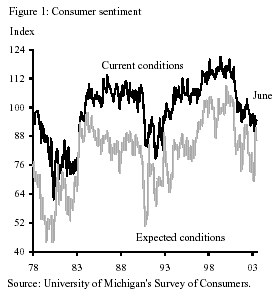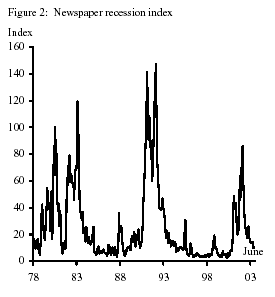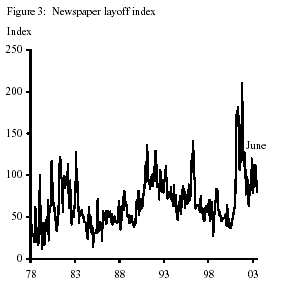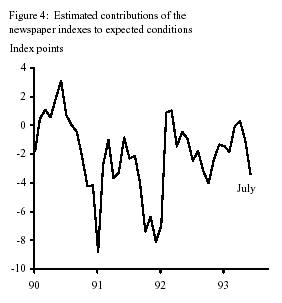Policymakers and forecasters pay close attention to a lot of indicators that help them understand the economy’s current condition and the conditions that are likely to prevail in the future. One of the key indicators is not a so-called “hard” statistic, like “Real Gross Private Domestic Investment.”
- Measures of consumer sentiment
- How do consumers form their expectations about the economy?
- Measuring the volume and tone of reporting
- How are the newspaper indexes related to consumer sentiment?
- News matters
- Reference
Policymakers and forecasters pay close attention to a lot of indicators that help them understand the economy’s current condition and the conditions that are likely to prevail in the future. One of the key indicators is not a so-called “hard” statistic, like “Real Gross Private Domestic Investment.” Rather, it is a measure of the mood of consumers, who are a hugely important part of the economy, accounting for two-thirds of the country’s economic activity. This measure of consumer sentiment has been of interest over the years for two reasons. First, through it, consumers may be telling us something about the economy that traditional economic statistics might be missing. Second, consumers’ perceptions of the economy may influence their spending decisions; for example, if consumers are filled with angst, then they may reduce their spending.
As significant as this measure is, there is still little understanding of how consumers form their impressions about the economy. One would expect that it would depend primarily on economic fundamentals, such as employment growth, the unemployment rate, the stock market, and gasoline prices. This Economic Letter reports on new research by Doms and Morin (2004) that explores this question. Their research finds that, in addition to moving in line with these economic fundamentals, consumer sentiment also swings in response to the tone and volume of economic reporting by the media. Over the past 25 years, there have been several periods when the tone and volume of economic reporting pushed consumer sentiment significantly away from what economic fundamentals would suggest.
Measures of consumer sentiment

One of the more popular measures of consumer sentiment is the University of Michigan’s Survey of Consumers (SC). The SC samples about 500 households each month and asks about current and expected economic conditions. The scope of the questions is broad, ranging from the respondent’s personal economic conditions to his impressions of the overall business climate. The SC publishes indexes on consumers’ perceptions of current conditions, expected conditions, and an average of the two, known as the composite index (among others). Figure 1 plots the time series for the current and expected conditions measures (the composite index, not shown, lies between these two series); clearly, both measures can swing quickly and abruptly, as they did in the summer and fall of 1990 and again in late 2000 and early 2001.
What is surprising is how sentiment varies over time relative to economic conditions. For instance, the expected conditions index fell in the early 1990s, during a relatively mild recession, to levels close to those seen in the early 1980s, when the recessions were much more severe. Also, during the most recent downturn, expected conditions fell some, but not as much as they did during the downturn in the early 1990s, which was similar in magnitude and length. Understanding why sentiment, especially the expected conditions index, behaved this way is one of the issues that Doms and Morin address.
How do consumers form their expectations about the economy?
Doms and Morin posit that not only are economic fundamentals important determinants of consumers’ perceptions, but so are the tone and volume of media reporting on the economy. Consumers get information about economic fundamentals (which include such data as unemployment, inflation, GDP, developments in financial markets, and gasoline prices) from personal experiences, including the experiences of friends and family, and from the media.
However, the perceptions of consumers may be influenced not only by the content of the news stories they come across but also by the way the media cover the economy—specifically, the tone reflects the language used, and the volume reflects the number of articles about the economy. In terms of tone, the headline “Recession Possible” is likely to elicit a greater negative impression about the economy than an article entitled “Economic Conference Presents Diverse Views” in which the possibilities of a recession are discussed in the last paragraph. Misgivings about using the word “recession” have been expressed over the years, sometimes tongue-in-cheek; Alfred Kahn, chairman of the Council of Wage and Price Stability during the Carter administration, went so far as to substitute the word “banana” for “recession” in a speech. In terms of volume, seeing ten articles about layoffs—even though the articles contain similar content—may have a greater effect on a consumer’s perceptions about the economy than seeing only a single article about layoffs.
Measuring the volume and tone of reporting


To test whether the tone and volume of reporting affect people’s perceptions, Doms and Morin constructed indexes to measures the tone and volume of economic reporting over time. The indexes are based on the number of articles that contain certain keywords and phrases in the title or first paragraph. For instance, the “recession index” is based on the number of articles that mention “recession” or “economic slowdown.” The authors scanned articles from thirty of the largest newspapers across the country. The idea behind the recession index was borrowed from the “R-Word Index” from The Economist which counts the number of articles from the Washington Post and The New York Times mentioning the word “recession.”
The “layoff index” measures the number of articles that mention “layoffs,” “downsizing,” and “job cuts.” One reason for creating such an index is that several consumer sentiment questions deal specifically with the job market. Additionally, consumers closely monitor the job market. Doms and Morin constructed a number of other indexes, as well, but those seemed to have little bearing on consumers’ perceptions of the economy.
The recession index is shown in Figure 2 and the layoff index in Figure 3. One of the more stark features of the recession index is the size of the spikes in the early 1990s when levels are higher than those reached in the more severe recessions in the early 1980s and much higher than the levels reached during the most recent recession. The layoff index also has surprising spikes: the index was much higher in 2001 than in the early 1990s and early 1980s. By contrast, the actual deterioration in the employment market was much worse in the early 1980s, when the unemployment rate reached nearly 10.8%, than during the most recent slowdown, when the unemployment rate peaked at 6.3%.
How are the newspaper indexes related to consumer sentiment?

Doms and Morin use the recession and layoff indexes to explain the departure of sentiment from measures of economic fundamentals. After controlling for economic fundamentals, Doms and Morin find that the recession and layoff indexes assist in explaining the swings in sentiment, especially the downward swings in the early 1990s and in 2000/2001. To demonstrate the power of the newspaper indexes on sentiment, Figure 4 plots the estimated contributions of the newspaper indexes to the expected conditions index for the early 1990s, a period in which consumer sentiment recorded low values. The figure shows that there were several months when the newspaper indexes shaved about eight points off the expected conditions index and many more months where sentiment was lowered by a handful of points. Additionally, there were several months in which the newspaper indexes boosted sentiment.
These results suggest that consumers pay attention to the media’s reporting of the economy and that perhaps the tone and the volume of reporting affect consumers’ perceptions above and beyond the facts and opinions being reported. The newspaper indexes also appear to explain people’s feelings about expected conditions a bit better than current conditions.
A key question is how long-lived the effects of the media’s tone and volume are on people’s perceptions of the economy. Doms and Morin find that the newspaper indexes affect sentiment for only a month or two; after a couple of months, the effects of reporting are nearly nonexistent. Finally, Doms and Morin also explore more complex models of news reporting and consumer sentiment. One of the conclusions they reach is that the news reporting considerably clouds the understanding of month to month movements in consumer sentiment. In fact, they show that, under special circumstances, it is possible that an increase in “bad news” reporting (as measured by the recession and layoff indexes) may actually result in a short-term increase in consumer sentiment.
Doms and Morin show that while consumer sentiment is affected by economic fundamentals, media reporting also plays a role. Specifically, they find that deviations in sentiment from economic fundamentals are partially explained by constructed indexes of the tone and volume of news reporting, which may or may not align with what is happening in the economy. In fact, there are several periods when reporting on the economy appears to be extreme relative to economic fundamentals. Consequently, people’s views about the economy deviate for short periods of time from what economic fundamentals would suggest.
Mark Doms
Senior Economist
Doms, Mark, and Norman Morin. 2004. “Consumer Sentiment, the Economy, and the News Media.” FRBSF Working Paper 2004-09.
Opinions expressed in FRBSF Economic Letter do not necessarily reflect the views of the management of the Federal Reserve Bank of San Francisco or of the Board of Governors of the Federal Reserve System. This publication is edited by Anita Todd and Karen Barnes. Permission to reprint portions of articles or whole articles must be obtained in writing. Please send editorial comments and requests for reprint permission to research.library@sf.frb.org